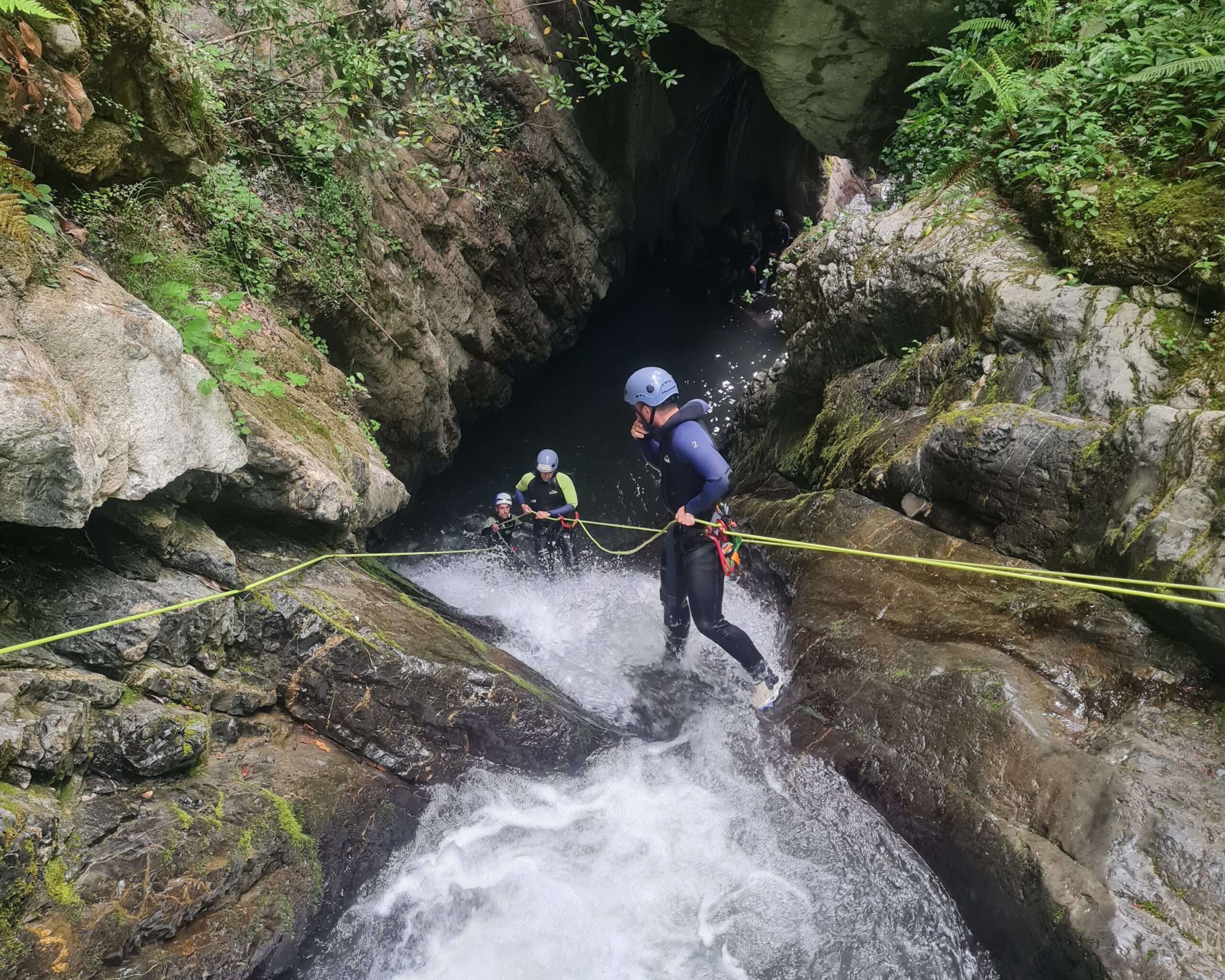For those who still don’t know anything – or very little – about one of the trendiest activities among adventurers… At Cangas Aventura, we’ll tell you everything! Canyoning is an exciting sport that combines exploring natural canyons with the application of multiple technical skills. It’s a discipline that offers a unique experience to the most intrepid, who must descend through incredible canyons overcoming a wide variety of obstacles, such as waterfalls, pools, or rocks. Not to mention enjoying the magnificent landscapes you pass through during each route!
And what techniques can be applied during canyoning? It all depends on the canyon you choose. However, to enjoy this activity to the fullest and safely, it’s essential to know the most important or most common techniques and disciplines. But don’t worry! If you’re a beginner or don’t feel very confident practicing canyoning on your own, you can choose to book the activity with a specialized company. This way, you’ll have a guide who will instruct you on how to overcome each obstacle and ensure your safety.
Techniques Used in Canyoning
- Rappelling: rappelling is a crucial technique in canyoning. It involves descending with a rope from a variable height depending on each canyon, which could be down a waterfall or a cliff. For this, adventurers use descent devices and anchor systems to control their speed and safety during the descent. In short, rappelling is the most common technique for overcoming vertical obstacles in the canyon.
- Swimming: while some canyons are more aquatic than others, either due to their route or the time of year they are practiced, most canyons include water sections, such as pools or even small lakes. The ability to swim is essential to move through these areas safely. It’s also important to know floating and rescue techniques in case of emergency.
- Waterfall jumping or jumping into water pools: some canyons present the opportunity to jump from waterfalls or rocks into water pools. This discipline requires jumping skills and sometimes diving skills to ensure safety and avoid injuries.
- Climbing and hiking: before and after the descent in the canyon, it’s often necessary to walk or climb through varied terrains. Athletes must be prepared to walk on irregular and steep terrains and, occasionally, climb rocks to reach the starting or exit point of the canyon.
- Rope techniques: in addition to rappelling, situations may arise where more or less advanced rope techniques are required, such as the use of fixed ropes to overcome obstacles.
- Orientation: the ability to orient oneself in natural environments is essential. Canyons can be remote and maze-like places, so it’s important to know the terrain, have an experienced guide, or carry a map or GPS and be prepared for orientation.
Additionally, it’s vital to address other issues for proper performance of the sport in completely safe conditions. These issues are none other than being instructed in basic rescue techniques, being aware of the weather conditions for the day on which the descent will take place, and understanding the importance of respecting the natural environment.
- Rescue techniques: safety is a priority in canyoning, as it is still a risky sport. The most experienced athletes in the discipline are trained in rescue techniques in case of accidents or emergencies. This includes the ability to help companions in difficult situations and perform first aid if necessary.
- Weather conditions: whenever canyoning is to be practiced, it is important to be attentive to weather conditions, as rainfall can increase water levels in canyons, which can significantly affect safety. Planning and preparing for weather changes are essential.
- Environmental conservation: canyoning enthusiasts should be aware of the importance of environmental conservation. They must respect local flora and fauna, leave no waste, and follow local regulations to minimize their impact on nature.
Canyoning in Asturias or Barranquismo in Asturias
As we mentioned earlier, canyoning or barranquismo is an activity that offers an unforgettable experience in nature, especially in beautiful settings like those in Asturias. And some of the best canyons in Asturias can be enjoyed with the guides from Cangas Aventura. Do you want to try canyoning in Cangas de Onís? Do you prefer canyoning in Arriondas, canyoning in Llanes, or canyoning in Ribadesella? Cangas Aventura, in the heart of Asturias, offers canyoning enthusiasts a paradise of options to explore. Canyoning in Asturias is a unique experience!
The canyons of Asturias offer varied challenges, from impressive waterfalls to crystal-clear waters and dreamlike landscapes. Among the most notable are the Vallegón canyon, La Molina canyon, or the Viboli canyon, known for their natural beauty and the excitement they provide. Other canyons equipped for descent in the region, with different levels of difficulty, are the Rubó canyon or the Carangas canyon, beyond canyoning in the Sella.
If you’re looking to go canyoning in Asturias, don’t forget that safety and proper training are fundamental to enjoying the diversity of canyon descents that the region offers. Therefore, it is advisable to have experienced guides who know the canyons in the area and are trained to teach the necessary techniques. Canyoning in Cangas de Onís and its surroundings is an opportunity to explore the natural beauty of Asturias while enjoying the excitement and adrenaline that this thrilling outdoor activity provides.
In conclusion, canyoning is an exciting activity that combines a series of disciplines and techniques for the enjoyment of adventurers. Mastering these skills is essential to explore impressive natural environments in a responsible and exciting way.

